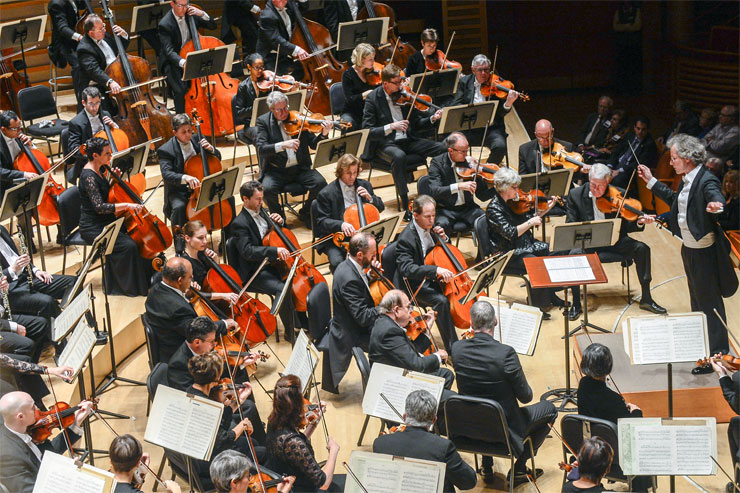
Music Director Franz Welser-Most, The Cleveland Orchestra at the 10th Anniversary Season, at Adrienne Arsht Center for the Performing Arts on January 29, 2016 in Miami, Florida. (Photo by Rodrigo Varela/Getty Images for The Cleveland Orchestra).
Many things inspire composers; even a love letter and recycled material can become the stuff of great classical music.
Conductor Franz Welser-Möst and The Cleveland Orchestra brought a musical letter of reconciliation from Brahms and two works of repurposed music from Prokofiev to the stage of the Knight Concert Hall at the Adrienne Arsht Center in Miami on Jan. 29 and 30. The program was part of the celebration of Cleveland Orchestra Miami's Tenth Anniversary Season.
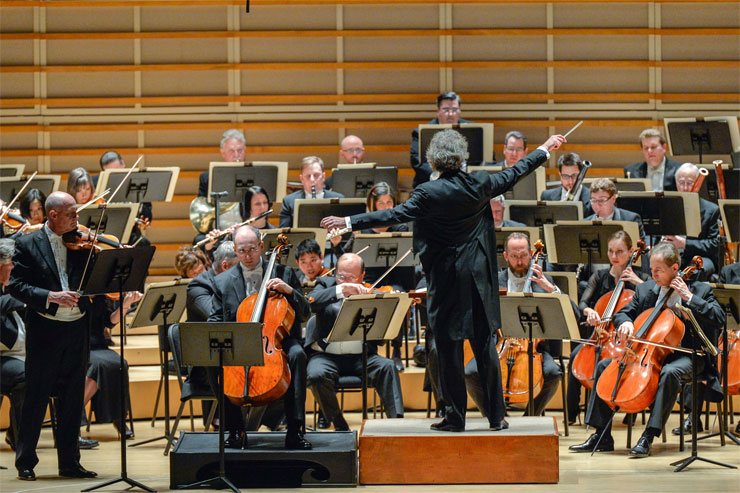
Music Director Franz Welser-Most, soloists: Concertmaster William Preucil and Principal Cellist Mark Kosower with the Cleveland Orchestra at the 10th Anniversary Season, at Adrienne Arsht Center for the Performing Arts on January 29, 2016 in Miami, Florida. (Photo by Rodrigo Varela/Getty Images for The Cleveland Orchestra)
Brahms’s Double Concerto (for violin and cello) in A minor was his final work for orchestra. He crafted it as an olive branch to his dear but estranged friend, Violinist Joseph Joachim.
Over the past few musical centuries, a composer writing a double concerto was unusual, and writing one for a violin and cello even more so. If self-deprecation is meant to lower expectation in order to bring a favorable result, Brahms did so in calling his double concerto “my latest folly.”
Brahms wasted no time revving it up with an instantly recognizable three-note musical motto at the opening of the first movement. TCO’s Principal Cello Mark Kosower then quickly took the spotlight with a rich relaxed melody, strumming his honey-toned instrument like a guitar just as Concertmaster William Preucil struck up a conversation with the cello, which never relented over the entirety of the concerto.
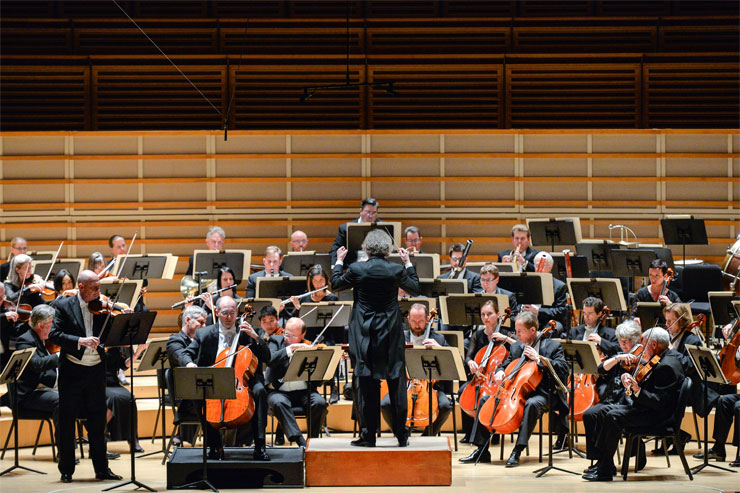
Music Director Franz Welser-Most, soloists: Concertmaster William Preucil and Principal Cellist Mark Kosower with the Cleveland Orchestra at the 10th Anniversary Season, at Adrienne Arsht Center for the Performing Arts on January 29, 2016 in Miami, Florida. (Photo by Rodrigo Varela/Getty Images for The Cleveland Orchestra)
Kosower expanded the motif and the conversation between the two soloists turned more serious, their lyrical voices stitched into the fabric of the more pointed orchestra as they continued to beautifully echo each other.
The second movement was a peaceful stroll, the equally matched musicians again echoing each other’s pleasure. The lovely principal melody and a second theme blended sublimely between soloists and orchestra, Brahms score somehow keeping the orchestra separate and intricately fused simultaneously with the soloists.
Virtuoso moments and the Brahmsian melodies continued as cello and violin got busy in the finale, skillfully advancing the nimble rondo theme (main melody alternating with subordinate ideas), sharing and passing them around between themselves and the energized TCO. A figure that kept changing keys, and multiple stops (notes played simultaneously across multiple strings), peppered the movement as soloists and orchestra brought the concerto across the finish line.
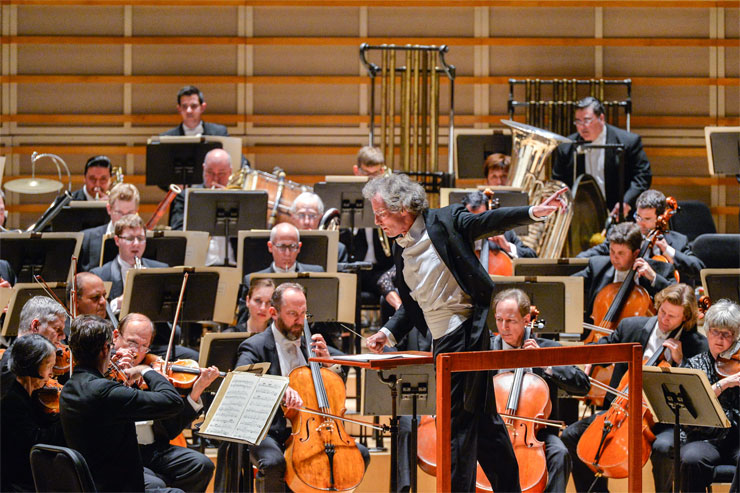
Music Director Franz Welser-Most, The Cleveland Orchestra at the 10th Anniversary Season, at Adrienne Arsht Center for the Performing Arts on January 29, 2016 in Miami, Florida. (Photo by Rodrigo Varela/Getty Images for The Cleveland Orchestra).
The thin and animated Welser-Möst stood on his podium next to the internationally accomplished Preucil and Kosower, whose active elbows, emotional facial expressions and intense body language illustrated a passionate performance, both individually and as a duo.
Recycling music is not new. Irving Berlin once put a tune of his aside since it didn’t fit in a musical review of his and then repurposed it for Kate Smith 20 years later. Oh yeh, the tune was “God Bless America.”
For his Divertissement, Opus 43, Prokofiev salvaged movements from an early ballet (Trapèze) and combined them with movements he composed later in his life, perhaps portraying a personal time-lapse picture of himself, moving from his youthful rhythmically-driven music to the warmer and melodic sound of his maturing character.
Welser-Möst deftly led TCO’s remarkable musicians through the four movement composition, phat with personality. Trumpets, flutes and percussion out of the gate were supported by the lower voices, the tuba omnipresent throughout. After a Russian motif was taken up by the bassoon, more colorful ideas quickly bounced from section to section. Angling toward conclusion, a romantic theme was launched, picking up speed before a brief respite morphed into a peppy sprint with a sudden humorous finish.
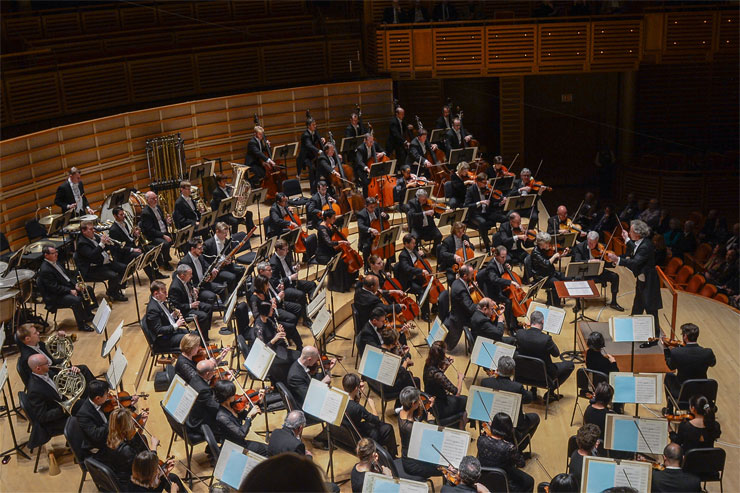
Music Director Franz Welser-Most, The Cleveland Orchestra at the 10th Anniversary Season, at Adrienne Arsht Center for the Performing Arts on January 29, 2016 in Miami, Florida. (Photo by Rodrigo Varela/Getty Images for The Cleveland Orchestra)
Prokofiev rescued music from his unproduced opera, The Fiery Angel, and imbued it into his Symphony No. 3 in C minor.
It may be unfair to say that the story – a 16 year old girl seeking a relationship with an angel “incarnate among the men she meets” – shows up musically in Prokofiev’s third, but to this reviewer something irregular, complicated and phantasmagorical was certainly conjured up in this unusual symphony.
Figures passed into each other, changed shape, dissolved and appeared amidst signature Prokofien melodies and harmonies in all four movements.
A blustery motif opened the first movement and receded into an expansive lyrical melody, assumed by the violins and horns, which kept changing shape as if inspired by a dream or as created by the imagination. The strings change direction and the different sections of the orchestra mashed together while marching brass and hard-driving percussion steadily gained momentum. The strings (and various voices) suddenly took up the main theme again and expanded it exponentially into epic proportions. The trumpets broke into their marshal theme and the movement quieted with the opening figure wafting among the winds and strings, a disquieting contrabassoon ending the movement.
A gentler and more forgiving theme from the winds claimed the second movement, the strings and harp enhancing the dreamy texture. Violin glissandos marked the beginning of their assent into the upper atmosphere. Like the first, there was no button to end the movement’s conclusion.
TCO was off and running in the third, ebb and flowing like agitated surf, glistening violins portending a mounting storm; lightning struck, wind and rain swept in, the whirlwind seemed to break, and a little sunlight shined through. The wind picked up, solo trumpet amid pounding drums turned in thunder, dissonant chords peaked, and came another abrupt ending.
A dramatic opening to the finale set the stage for a multi-tempoed ride. Violins propelled by crashing cymbals marched steadily forward, trumpets blared, and after a brief return to a languid dreamlike state, all hell broke loose; a chime was struck, and the panoramic sound wrapped up with a large dissonant chord, taking the audience off guard one more time. It was a good 10 seconds before the first hands began to clap for the mighty performers.
This was musical Sci-Fi – fantastical, spacious and captivating.
Cleveland Orchestra Miami’s season concludes with performances on March 17, 18 and 19 under Principal Guest Conductor Giancarlo Guerrero, featuring a world premiere of a new work by native Israeli, Avner Dorman, commissioned for TCO by the Adrienne Arsht Center. Also on the program will be Mahler’s Symphony No. 1 (“Titan”) and pianist Jean-Yves Thibaudet will perform Liszt’s Piano Concerto No. 2.
clevelandorchestramiami.com
 MAIN MENU
MAIN MENU

